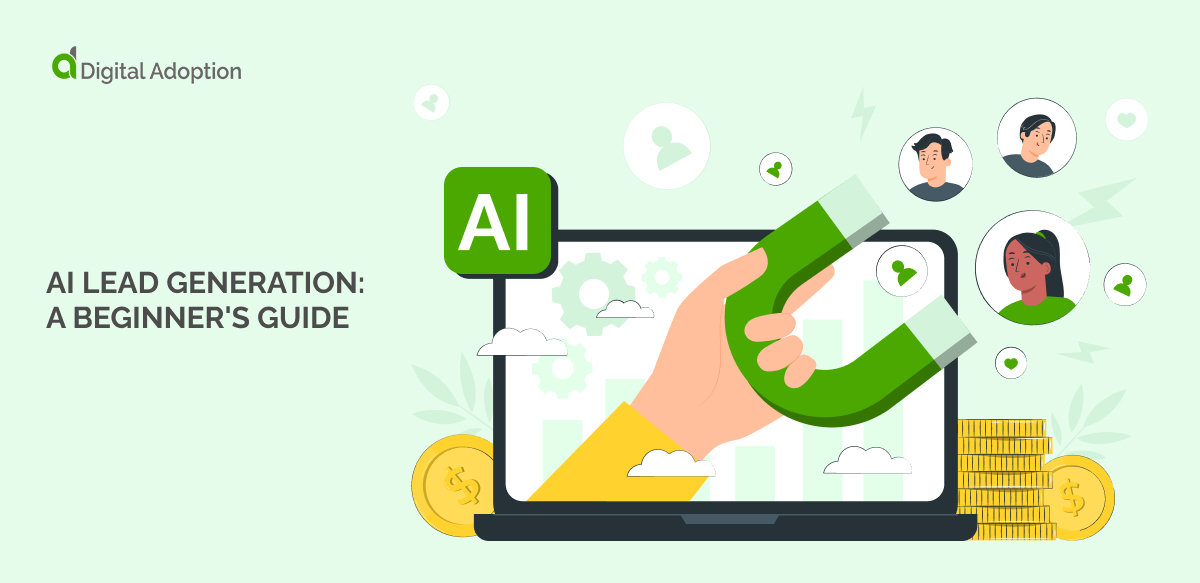Folks in lead generation know all about information overload. There are so many contacts to track! So many calls to make! And so many messages and emails to send!
It’s a real challenge. So it’s no surprise that lead generation teams have been joining forces with AI for years, as a vintage McKinsey report from way back in 2016 shows.
However, the rise of generative AI has changed everything. Applying AI to sales opens doors to many use cases throughout the customer journey. And lead generation is no exception. Lead generation relies on big databases, repetitive tasks, and routine conversations.
Generative AI is a natural ally of lead generation. If that’s news to you, this article will give you a rundown of how it works.
We’ll start by providing a concise explanation of AI in lead generation. Next, we’ll introduce key techniques for leveraging AI in lead gen. We’ll then present an overview of the market’s available AI-powered tools for lead gen.
Lastly, we’ll explore the significant risks associated with AI lead generation.
AI Lead Generation: The Basics
Lead generation is the process of identifying potential customers for a product or service.
With AI Lead generation, the sales team applies the power of generative AI to their lead generation activities. AI tools can enhance the full process, from lead capture to outreach to the reactivation of old contact databases.
AI has been used in sales and lead generation for some time. AI-powered analytics have helped companies use big data sets to discover the most likely prospects for years. AI tools have a track record of supporting efficient, effective, and reliable lead-generation activities.
When we bring generative AI into the picture through ChatGPT, Bard, and 3rd party software, the benefits of AI for lead generation start to make a huge difference.
Generative AI means that many tasks can be scaled rapidly and efficiently. Even if you spend monthly subscriptions for the right tools, AI tools can quickly deliver a startling ROI.
Right now, thought leaders in sales are keeping quiet about the limitations of AI-based lead generation.
After all, everyone’s still in the first wave of hype about this new technology. But the challenges are easy to spot. Sales fundamentally rely on human empathy and connection in a way that the best AI bot cannot emulate. Intuition, networking, and decision-making capabilities are not AI’s strong suit.
Some of the features of AI lead generation
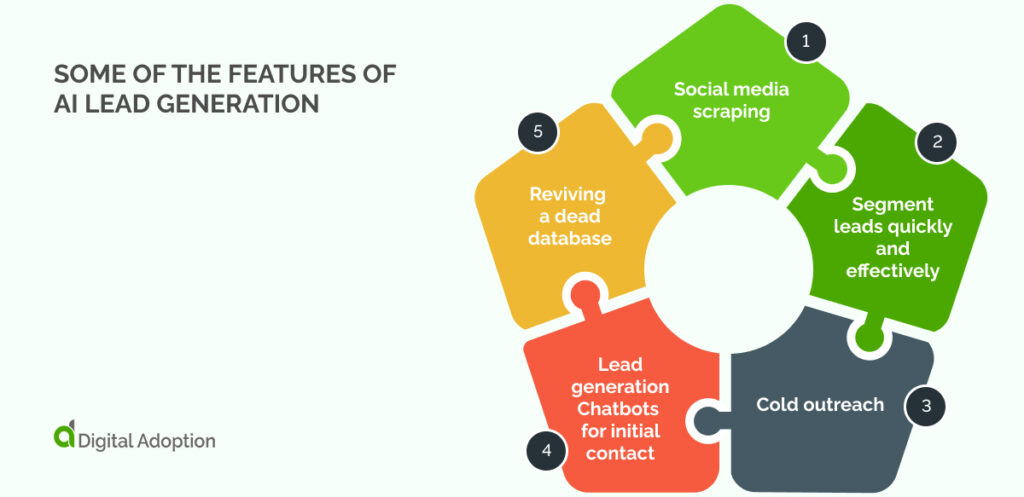
Lead generation strategies include a wide range of activities. Lead gen professionals must find a target audience to generate leads, qualify leads (with lead scoring tactics), contact qualified leads, undertake lead nurturing tasks, and more.
Sales and marketing teams may already have lead-generation strategies in place. However, generative AI can enter the process at every stage. Let’s take a look at some important possibilities for AI lead generation.
Social media scraping
AI can help collect data from social media platforms like LinkedIn.
With the right prompts, you can use AI to filter LinkedIn contacts by searching their profiles for specific and relevant terms. This helps identify potential leads that align with your criteria, saving both time and effort.
AI can also be employed to extract precise data from a large pool of profiles swiftly. This automated approach is a game-changer, as it accomplishes tasks that could take hours, days, or even weeks in just an instant.
It’s important to note that while AI streamlines the process, compliance with platform rules is crucial to avoid any potential violations.
Segment leads quickly and effectively
A 2023 McKinsey report on AI in Sales explains that segmentation is one of the core capabilities of AI. With advanced AI algorithms, marketing and sales teams can ” identify segments with unique traits that may have been overlooked in existing customer data.”
Swift processing and deciphering massive datasets unveil valuable insights, identifying distinctive buying patterns and behaviors.
This data-driven approach enables sales professionals to pinpoint precisely when and how to engage potential customers, tailoring their strategies accurately.
With Generative AI as their ally, sales teams are better equipped to deliver personalized and compelling sales pitches that resonate with their audience’s unique needs and preferences, ultimately driving higher conversion rates and sales success.
Cold outreach
Once you’ve gathered your contact lists, modern generative AI lead generation tools can take your outreach to the next level. Personalization is the key for any business owner looking to generate leads, especially high-quality ones.
Text-based outreach is made effortless with generative AI. You can use chatbots to craft personalized messages by setting simple parameters. Sending these messages to your leads is as simple as a few clicks.
Another noteworthy advancement lies in AI-generated videos for personalized outreach. Creating a hundred unique videos has become fairly straightforward, enabling you to engage with your leads in a more personalized and impactful manner.
In one surprising statistic, a report from Gartner predicts that 30% of outbound marketing messages will be AI-generated by 2025.”
Looking at the latest tech, it’s certainly possible.
Lead generation Chatbots for initial contact
Chatbots are going to revolutionize the whole of the customer journey. But they are especially valuable when it comes to lead generation.
Bots act as initial filters for potential customers, especially cold leads. When a cold lead interacts with your website, the chatbot can swiftly gauge their interest and intent.
The chatbot determines if the lead aligns with your ideal customer profile through specific questions and response analysis, aiding lead qualification. Should the lead meet the criteria, a seamless handover to a sales representative for further engagement is possible.
This streamlines the lead qualification process and ensures that your sales team spends their time on the most promising leads, ultimately boosting sales efficiency and conversions.
Chatbots are likely to be a major business sales tool in the future. This may seem a bit strange. But we’re not so far away from this reality.
Reviving a dead database
While AI is gradually becoming integral to the entire lead generation process, it currently holds a unique role for older databases of potential leads.
With a “dead” database in hand, lead generators need some serious power to sift through the results: AI-powered engines are uniquely capable of this task.
First, they identify segments within the database that show surprising promise. AI aids in swiftly identifying these segments and enables the automation of messages.
Leveraging AI can help uncover overlooked or dormant opportunities and possibilities. This revitalization process allows you to tap into the full potential of your existing database and engage with high-quality leads effectively.
Database revival uses all the strengths of AI to create great results. But a human being must still operate the tools.
Experienced lead generation experts, such as Dan Wardrope and Jamie Woods, are demonstrating their expertise and showing us how it’s done. You can see their valuable insights in action here.
AI lead generation tools to make your sales funnel move
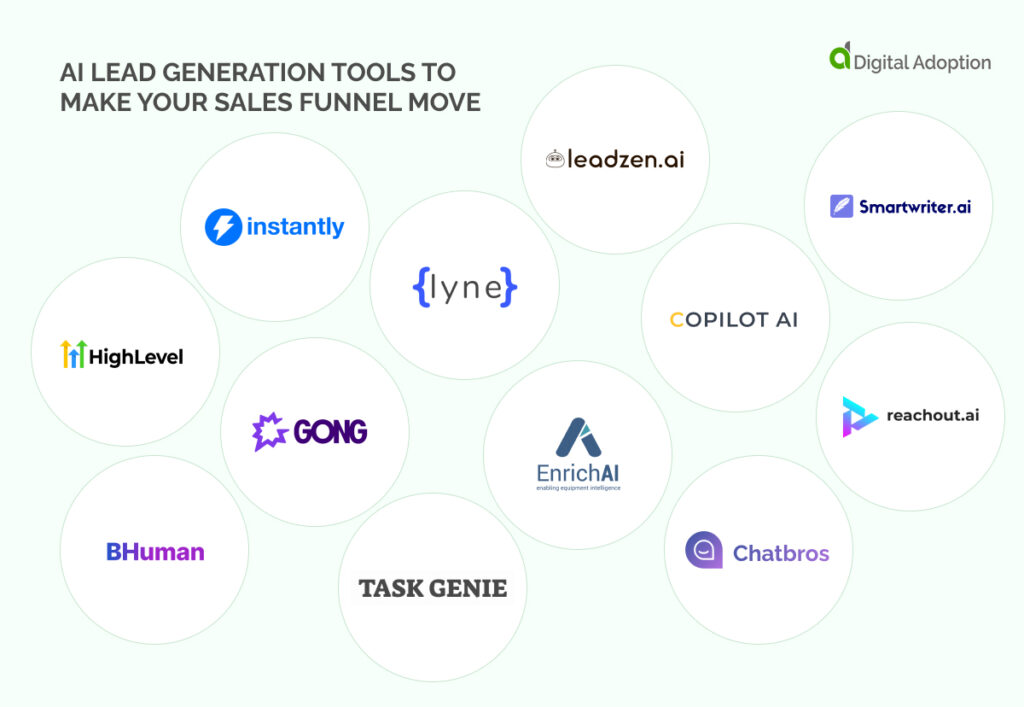
How will you start generating leads with artificial intelligence? The simplest way is with one of many third-party tools.
When other AI lead-generation efforts fail, they prove to be highly valuable. For instance, scenarios like onboarding new staff, providing specialized training, and implementing prompt engineering from within may yield different results.
If you’re looking for rapid results, these tools could help you reach your target audience:
- Instantly AI: Instantly AI offers artificial intelligence solutions to help businesses automate their processes and improve efficiency.
- LeadZen: LeadZen is a lead generation company that uses AI to provide high-quality business leads.
- Lyne AI: Lyne AI develops chatbots for businesses, helping them automate customer interactions and deliver excellent customer service.
- Smartwriter: Smartwriter is an AI-powered writing assistant that can generate content across various formats, including emails, blog posts, and social media posts.
- Copilot AI: Copilot AI leverages artificial intelligence to automate sales outreach, helping businesses connect with their target audiences more effectively.
- High Level: High Level is an all-in-one marketing platform for businesses, combining CRM, email marketing, and other functionalities.
- Gong.IO: Gong.IO uses AI to analyze sales calls and meetings, providing insights to help sales teams close deals more efficiently.
- Enrich with AI: Clearbit’s Enrichment tool uses AI to provide businesses with comprehensive data about their customers, helping them make informed decisions.
- Reachout with AI: Reachout with AI is a platform that uses artificial intelligence to automate and personalize email outreach.
- bHuman.ai: bHuman.ai is an AI-powered platform that helps businesses build more human-like digital experiences.
- Task Genie: Task Genie is an AI-powered task management tool that helps teams streamline workflows and improve productivity.
- Getlead.ai: Getlead.ai is a lead generation platform that uses artificial intelligence to help businesses find and connect with their ideal customers.
- Chatbros.ai: Chatbros.ai is a chatbot development platform that allows businesses to automate their customer service and improve customer engagement.
There are plenty of obvious advantages to using 3rd party software.
These tools often bring expertise, advanced algorithms, and extensive data resources that may surpass in-house capabilities.
Tapping into external AI solutions allows businesses to access more accurate lead insights, faster data processing, and innovative lead generation techniques. This enhances their efficiency in identifying and engaging high-quality prospects.
The risks (and limits) of AI lead generation
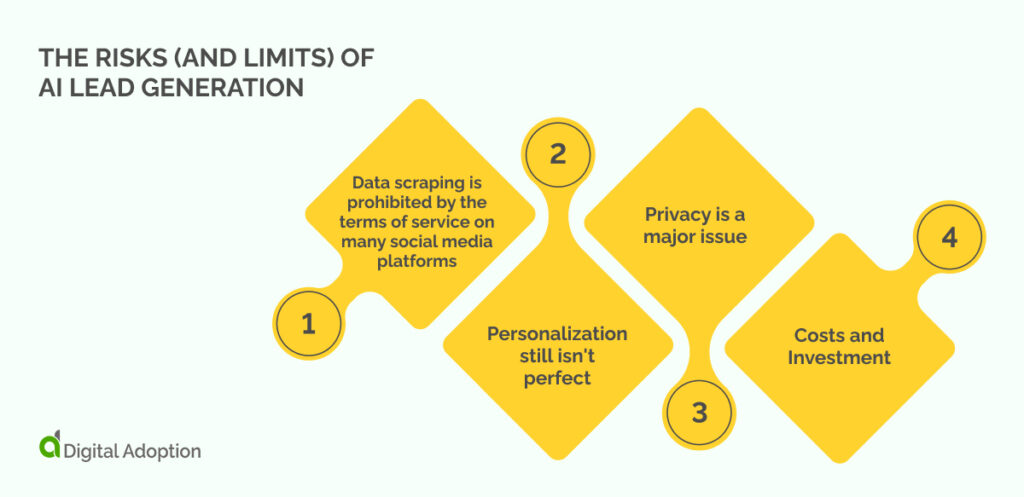
Like any business application of AI, AI lead generation mixes opportunities with AI risks.
These risks of AI, in general, are well-documented. But what about the specific challenges when it comes to AI?
Before you rush head-first into adding AI to your lead generation processes, consider these weak points:
- Data scraping is prohibited by the terms of service on many social media platforms, including LinkedIn. If you use ChatGPT or Bard for invasive purposes – you could end up in big trouble with the LinkedIn police!
- Personalization still isn’t perfect. Of course, the developers of AI sales tools boast that their tools produce “real-life” content. But will customers be fooled? Tread carefully if you are using AI for customization.
- Privacy is a major issue. We still don’t know how AI engines use, retain, and re-package data. Mishandling or data breaches can lead to major legal and reputational issues.
- Costs and Investment. Implementing AI solutions can be costly, and businesses may not see a return on investment if the technology is not used effectively—the AI-powered tools listed above all charge hefty monthly subscription fees.
Is AI the future of the lead generation process?
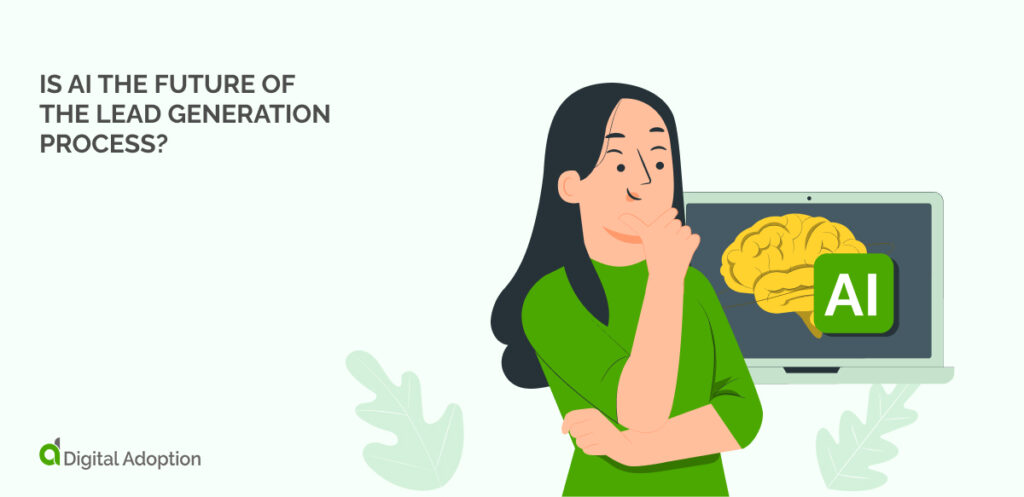
Investing in an advanced AI lead generation tool can significantly propel your sales strategy forward.
After all, how many companies DON’T need to generate quality leads regularly? AI brings major efficiencies over traditional methods.
This doesn’t mean you need to replace all of your sales staff overnight, far from it.
As we’ve seen, AI tools can be most useful when taking over ONE part of the lead generation process at a time. You don’t need to convert every lead generation task to AI overnight to feel the benefits.
Reviving a dormant database using AI hacks alone would be sufficient in and of itself.
More and more tools are being rolled out specifically to support lead generation. As the months roll by, finding an application that works well for your business needs will become easier and easier.

